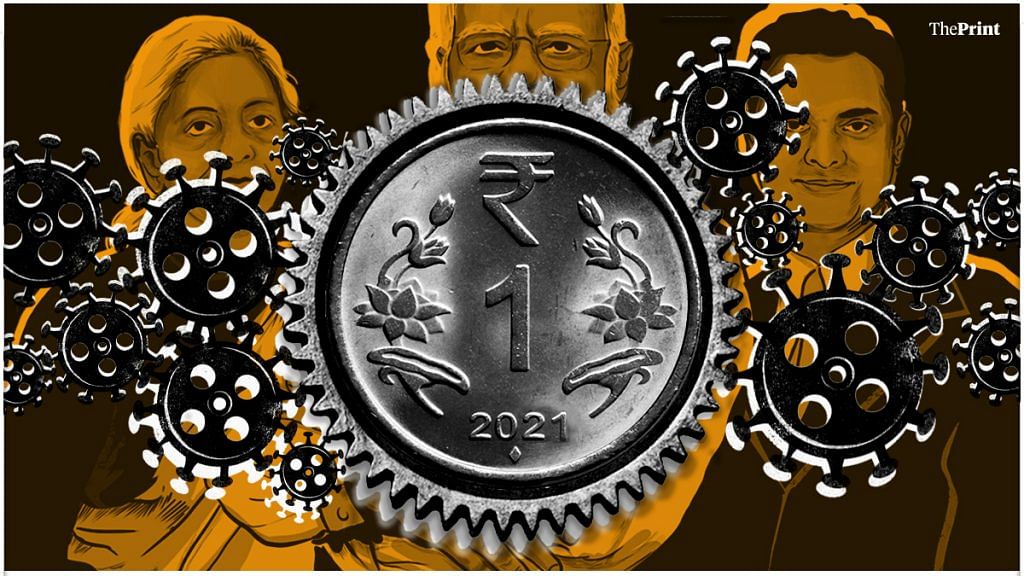Countries around the world adopted a wide range of fiscal and monetary policy measures in 2020 and 2021 to mitigate the economic and health impact of the Covid pandemic. In India too, the demand for a fiscal stimulus emerged from several quarters.
However, India’s policy response to the pandemic and the lockdown was relatively light on fiscal measures. While the Modi government announced a Rs 20 lakh crore-package post-lockdown to revive the economy, there was some criticism that the fiscal support measures were conservative and large cash transfers were needed to step up consumption.
The government’s policy response primarily focused on directed credit to small businesses and individuals backed by sovereign guarantee and a boost to capital spending. Chief Economic Advisor (CEA) K.V. Subramanian argued that taxpayer money needs to be well-directed. Credit to those that are distressed works better than unconditional cash transfers that are likely to be cornered by the undeserving. The strategy, although unpopular, was prudent.
Stimulus packages introduced in other parts of the world, including in the ASEAN countries and the US, focused primarily on direct measures like providing financial aid to households, businesses and people who lost jobs. India was more cautious.
Also read: Don’t fear crypto or digital currencies, let India’s young ride the online services boom
Why Indian response was sensible
As I argued in May 2020, given the uncertainty about the evolution of the coronavirus, the possible need for further lockdowns and the decline in tax revenue amid an already constrained fiscal space, the government was sensible in avoiding a large fiscal package.
India’s stimulus package focused on the provision of easier access to credit through reduced rates of interest as well as credit guarantee loans to reduce the damage to firms and households.
Recent research highlights that pandemic recessions are fundamentally different from ordinary recessions and thus require different policy responses.
In an ordinary recession, the role of policy is to step up aggregate demand and raise output consistent with full employment of resources. The policy response during a pandemic induced recession depends on the public health situation. Without effective public health measures, a broad-based demand stimulus would likely cause the virus to surge. Moreover, with uncertainty due to the virus, large cash transfers may not translate into higher spending. Even if they do, they can be inflationary.
India’s policy response needs to be seen in the backdrop of its fiscal situation.
Even before the pandemic struck, the fiscal space was fragile. Fiscal deficit in 2019-20 had widened to 4.6 per cent of GDP, overshooting the revised target of 3.8 per cent. The response had to be framed within the limited fiscal space. The key question was how to use the scarce resources towards the most vulnerable sections.
The ‘AatmaNirbharBharat’ package catered to various sections including migrant workers, agriculture sector, micro, small and medium enterprises and street vendors. It involved frontloading of transfers to farmers and distribution of free food grains. Subsequent measures focussed on boosting India’s manufacturing sector through a series of Production-Linked Incentive schemes.
Also read: Protecting livelihoods is the next frontier for India in the fight against climate change
How govt put India back on growth track
A key element of the government’s response strategy has been its focus on capital expenditure. Once the lockdown was eased, the expenditure policy was geared towards higher capital spending.
The government budgeted a 34.5 per cent rise, year-on-year, in capex to Rs 5.54 lakh crore for the current financial year. Capital expenditure through asset creation has a greater productivity effect.
Large scale fiscal spending by the government could have triggered inflationary concerns. At a time when the monetary policy response has been to reduce interest rates and infuse liquidity, a rise in demand-driven inflation could have complicated the conduct of monetary policy.
The Reserve Bank of India (RBI) did not raise interest rates because inflation was primarily due to supply-side disruptions, which cannot be addressed by higher rates. There are concerns in the US that the large fiscal spending will fuel inflationary pressures.
Due to low interest rates and a series of conventional and unconventional monetary policy instruments, the RBI was able to manage the government’s borrowing programme at an average interest cost of 5.79 per cent, lowest since 2004-05.
In contrast, emerging economies that undertook large stimulus measures had to resort to increased short-term government debt that has amplified refinancing risks. For example, in Brazil, federal debt held by the public due within the next 12 months increased from 18 per cent in December 2019 to above 28 per cent in December 2020.
Despite a brutal second wave, the GDP in the first quarter grew at 20.1 per cent in the first quarter. Since then the economy is seen to be recovering steadily.
While many high frequency indicators are showing that the economy is gaining momentum, the hiring intent has also picked up pace. India posted a GDP growth of 8.4 per cent in the second quarter, making the country the fastest-growing large economy in the world. The economy is likely to achieve double digit growth this year. Due to buoyancy in tax revenues, the government is also likely to achieve its fiscal deficit target of 6.8 per cent.
The economic revival approach of the government seems to have worked better than the strategy of pushing through large fiscal packages and printing money and then ending up with demand-fuelled inflation and unsustainable deficits and debt.
Ila Patnaik is an economist and a professor at National Institute of Public Finance and Policy.
Radhika Pandey is a consultant at NIPFP.
Views are personal.
Also read: How India’s informal economy is shrinking, and why that’s good news in the long term
